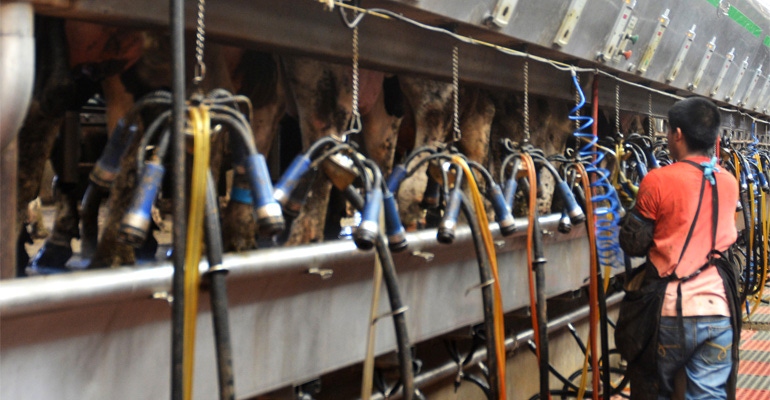
After a number of U.S. Bureau of Immigration and Customs Enforcement, or ICE, audits of dairies in New Mexico and Texas last year, Dr. Ellen Jordan, Texas A&M AgriLife Extension Service dairy specialist in Dallas, said the industry is working to help dairies get laborers properly documented.
Tiffany Dowell Lashmet, AgriLife Extension agricultural law specialist in Amarillo, led an employee immigration panel discussion on “Navigating the Dairy Workforce Crisis” recently at the High Plains Dairy Conference in Amarillo.
“Immigration is an important issue for all of agriculture, but particularly for the dairy industry,” explained Lashmet. “The vast majority of dairy owners want to comply with the law when hiring employees, so ensuring they know exactly how the law works and are educated on what their rights and responsibilities are is critical.”
Jordan and Lashmet recently wrote a publication, “The Difference between an ICE Raid and an ICE Audit: Are You Prepared?” which can be downloaded from the AgriLife Bookstore at: http://bit.ly/2iEwwLc.
“What we are trying to do is identify laborers and get them employed according to U.S. regulations, with an emphasis on what should be done to make sure they have proper documentation,” Jordan said.
“Traditionally a large portion of our workforce has been immigrants,” she said. “So producers need to know the changes in immigration policy and procedures.”
Jordan said the human resources panel was designed to address not only how to deal with ICE, but how to bring new employees on board with proper training so they are effective at doing their job and integrated into the farm team.
Sarah Thomas, a lawyer with Noble and Vrapi Immigration Attorneys in Albuquerque, New Mexico, said during the panel discussion that I-9 forms are required for every employee, regardless of race or status.
She said when the subpoena for an audit or notice of inspection is served at the dairy, there are several things all employees should know and the dairy should have trained them on.
“Designate who will talk to the agents and who will sign for the subpoena,” Thomas said. “You don’t want someone who doesn’t know what is going on or the time frame they have to comply.”
She said the employer has 72 hours from the time they receive the subpoena to gather data, during which time an employer should consider consulting an attorney and thoroughly reviewing all of their I-9 documents. Once the documents are turned over, the dairy will generally receive a letter of technical violations and have 10 days to show good faith and try to comply.
“We recommend you have a uniform policy with regard to copying documents presented by an employee completing an I-9 form by either taking or not taking copies of supporting documents,” Thomas said. “What you do for one employee, do for all employees.”
If an employer has taken all documents in good faith and complied with the record-keeping rules, she said, they are not liable. But in the end, if a worker is not able to be accurately documented, their employment must be terminated as it is illegal to knowingly employ someone who is not authorized to work in the U.S.
Thomas offered some suggestions on how to prepare and respond to an ICE visit:
Have a procedure in place and employees trained on what to do if ICE shows up at the dairy.
Obtain a copy of any subpoena or search warrant and send it to an attorney for review.
Do not voluntarily waive the 72-hour time period for producing I-9 documents.
Don’t allow officers into non-public areas without a search warrant granting them such access.
Don’t overtly share information that is not required.
Mark areas “Employees Only.”
Do your own audits internally to ensure I-9 documentation is in order.
Jordan said the number of on-farm employees in the dairy industry are generally figured at one for every 100 cows. So, in Texas, there’s an estimated workforce of 4,000, she said, and that doesn’t include the allied industries, such as veterinarians, technicians, nutritionists, milk truck haulers and others.
She said the labor force on dairies is continually changing, which equates to constant processing of paperwork.
While Jordan said the pay is good and that is what attracts the workers, it is physical labor and that can sometimes be the reason for the revolving door.
“The work is outdoors, and workers have to adjust and decide if they want to do that,” she said. “Many new employees start in the milking parlor and that is repetitive work. Also many workers have not done farm work at all, so they have to decide if that is a culture they want to be involved in.”
Also, if the owners and managers are able to engage the workers and help them learn their position to become a team member, it is more effective, Jordan said.
“Communication and building trust are key points of workforce management,” she said. “Most of our workers are coming without skills and those skills need to be developed on the farm. We need effective training so the workers are comfortable at their job and want to stay.”
About the Author(s)
You May Also Like




